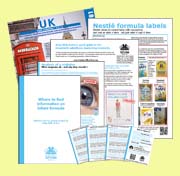Articles about Partnerships and Voluntary controls
Voluntary controls fail to reduce harmful advertising
Public health, corporations and the New Responsibility Deal: promoting partnerships with vectors of disease?
http://jpubhealth.oxfordjournals.org/content/33/1/2.long
The Medical Journal of Australia in June reports a study by Sydney researchers showing that fast food advertising had not declined but possibly increased since the introduction of voluntary controls.
An analysis by Rudd shows that since voluntary controls started in the USA the extent of TV advertising of junk food to children has not declined and actually increased strongly in 2010
http://www.plosmedicine.org/article/info%3Adoi%2F10.1371%2Fjournal.pmed.1001076
The findings of this paper suggest that tobacco company CSR strategies can enable access to and dialogue with policymakers and provide opportunities for issue definition. CSR should therefore be seen as a form of corporate political activity. This underlines the need for broad implementation of Article 5.3 of the Framework Convention on Tobacco Control. Measures are needed to ensure transparency of interactions between all parts of government and the tobacco industry and for policy makers to be made more aware of what companies hope to achieve through CSR.
Public health sector and food industry interaction: it’s time to clarify the term ‘partnership’ and be honest about underlying interests This paper by Corinna Hawkes and Kent Buse is published in the European Journal of Public Health, Vol. 21, No. 4, 400–403
"Public–private interactions to promote healthy eating now assume a role in the exercise of power that affect decisions about
how to address unhealthy eating and associated public health outcomes. They are thus not to be taken lightly. As their development gains pace, public health policy makers can and must continue their role in setting public health objectives. This is simply not an appropriate role for the private sector who are not, after all, public health officials. When it comes to public– private engagement for healthy eating, it is only after the public health objective has been set that policy makers should even think about engaging with the food industry".
http://info.babymilkaction.org/sites/info.babymilkaction.org/files/hawkes Buse partnerships EJPH_0.pdf
An analysis of the content of food industry pledges on food marketing to children Corinna Hawkes 1,* and Jennifer L Harris Public Health Nutrition
Conclusion The food industry has a long way to go if its pledges are to comprehensively reduce the exposure and power of marketing to children. ..... limitations in pledge coverage give the impression that, in both letter and spirit, the intention of the companies involved is not to reduce food marketing to children as much as they possibly can, but just to limit some direct marketing of very high-fat, high-salt, high-sugar products to children..... The question is thus whether the pledges are making a meaningful contribution to the gap left by governments, or whether the pledges are in fact being used to deflect governments from taking the more comprehensive action that WHO acknowledges would have a far greater impact. That the differences between pledges around the world reflect political (and other) pressures suggests that the government leadership recommended by WHO will be necessary if the industry is to take a more comprehensive approach towards ensuring that children are exposed to as little marketing – especially particularly powerful marketing – as possible.
http://journals.cambridge.org/download.phpfile=%2FPHN%2FS1368980011000607a.pdf&code=956f592c88e28fb20efbe7a12d05dd39
The Problem with Platforms: 2‐page rapid response to NCD Alliance from IASO .
http://info.babymilkaction.org/sites/info.babymilkaction.org/files/IASO Platforms and Partnerships.pdf
Other useful articles:
Global Health Philanthropy and Institutional Relationships: How Should Conflicts of Interest Be Addressed? Stuckler D, Basu S, McKee M (2011) PLoS Med 8(4): e1001020. doi:10.1371/journal.pmed.1001020
An analysis of the content of food industry pledges on marketing to children Public Health Nutrition by Corinna Hawkes (1) and Jennifer L Harris (2)
Submitted 31 August 2010: Accepted 25 February 2011
1 Consulting Services, Food and Nutrition Policy and Fellow, Centre for Food Policy, City University, London, UK:
2 Rudd Center for Food Policy and Obesity, Department of Psychology, Yale University, New Haven, CT, USA
EUROPEAN PLATFORM ON DIET AND PHYSICAL ACTIVITY
Short minutes-"Workshop PPP's on governance"
21 October 2008 Luxembourg.
......The following elements were identified for further discussion:
- Definition of Public Private Partnership the meaning of the word ‘partnership’ and whether other terms such as “interactions with the Private Sector’ might be more appropriate..
Rules of Governance of PPP's
- Roles of every actor within the PPP's.
- Management of Conflicts of interest.
- Independent monitoring : how to built “monitoring so that it remains independent and credible.
| Attachment | Size |
|---|---|
| Australia MJA fast food ads.PDF | 248.61 KB |
| 14.11.Pepsi WSJ.pdf | 181.07 KB |
| Gloabal Health Philanthrophy and COI.pdf | 162.21 KB |
| phn11hawkesfoodindustrypledges.pdf | 153.05 KB |
| RuddReport_TVFoodAdvertising_6.11 2.pdf | 46.07 KB |
| Page 1 eMJA.pdf | 100.74 KB |
| P1PHNhawkespledges.pdf | 46.67 KB |
| hawkes Buse partnerships EJPH.pdf | 47.97 KB |
| IASO Platforms and Partnerships.pdf | 161.23 KB |
| PPPs governance Eur Commission.pdf | 54.69 KB |
- Login to post comments






